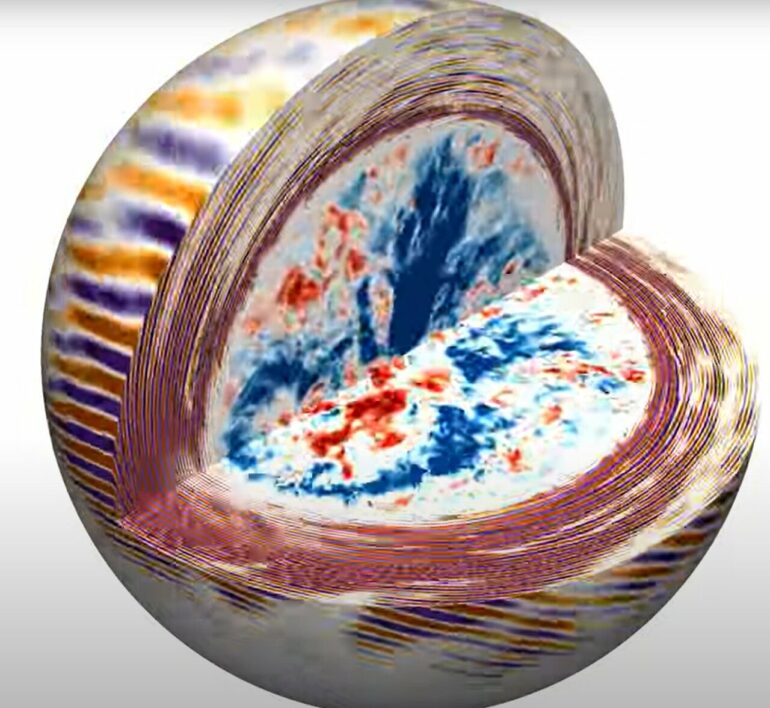Secrets hide in the twinkling of stars. A research team led by scientists at the Flatiron Institute and Northwestern University has created first-of-their-kind computer simulations showing how churning deep in a star’s depths can cause the star’s light to flicker. This effect is different from the visible twinkling of stars in the night sky caused by Earth’s atmosphere.
By closely observing the innate twinkling of stars, astronomers could one day use the simulations to learn more about what goes on inside stars larger than our sun, the researchers report on July 27 in Nature Astronomy.
The effects are too small for current telescopes to pick up, says study co-author Matteo Cantiello, a research scientist at the Flatiron Institute’s Center for Computational Astrophysics (CCA) in New York City. That could change with improved telescopes. “We’ll be able to see the signature of the core,” Cantiello says, “which will be quite interesting because it will be a way to probe the very inner regions of stars.”
A better understanding of stellar innards will help astronomers learn how stars form and evolve, how galaxies assemble, and how heavy elements such as the oxygen we breathe are created, says study lead author Evan Anders, a postdoctoral researcher at Northwestern University.
“Motions in the cores of stars launch waves like those on the ocean,” Anders says. “When the waves arrive at the star’s surface, they make it twinkle in a way that astronomers may be able to observe. For the first time, we have developed computer models which allow us to determine how much a star should twinkle as a result of these waves. This work allows future space telescopes to probe the central regions where stars forge the elements we depend upon to live and breathe.”
Intriguingly, the new simulations also widen a years-long stellar mystery. Astronomers have consistently observed an unexplained pulsing—or “red noise”—causing fluctuations in the brightness of hot, massive stars.
A popular proposal was that convection in the stars’ cores causes this flickering. The new simulations, however, show that the twinkling induced by core convection is far too faint to match the observed red noise. Something else must be responsible, the researchers report in their new paper.
A deep squeeze
A star’s convection is powered by the nuclear reactor at its core. In the heart of a star, intense pressure squeezes hydrogen atoms together to form helium atoms plus a bit of excess energy. That energy generates heat, which causes clumps of plasma to rise like the goo in a lava lamp.
But unlike a lava lamp, the convection is turbulent like a pot of boiling water. This movement generates waves just like those found in Earth’s oceans. Those waves then ripple outward to the star’s surface, where they compress and decompress the star’s plasma, causing brightening and dimming of the star’s light. By studying a star’s brightness, scientists realized they might be able to glean what’s going in the star’s core.
Simulating the wave generation and propagation in a computer is absurdly difficult, though, Cantiello says. That’s because while a wave-generating flow in the star’s core lasts a few weeks, the waves generated can linger for hundreds of thousands of years. Connecting those drastically different timescales—weeks and hundreds of millennia—posed a serious challenge.
The researchers took inspiration from a different form of waves: the sound waves that make up music. They realized that the convection-induced wave generation in the core is like a group of musicians in a concert hall. The musicians strumming their instruments produce a sound that is altered as it bounces around the venue.
The researchers found they could first calculate the unaltered “song” of the convection-induced waves and then apply a filter that replicated the star’s acoustic properties—a similar process to that of a professional sound engineer.
The researchers tested their method using sound waves from real music, including “Jupiter” from Gustav Holst’s orchestral suite “The Planets” and, rather appropriately, “Twinkle, Twinkle, Little Star.” They simulated how those sound waves would bounce around inside stars of different sizes, producing a haunting result.
After this validation of their approach, the researchers simulated the convection-induced waves and resulting starlight fluctuations of stars whose masses are three, 15 and 40 times that of our sun. For all three sizes, the core convection did indeed cause flickering light intensity near the surface, but not at the frequencies or intensities characteristic of the red noise astronomers had seen.
Convection may still be responsible for red noise, Cantiello says, but it would likely be far nearer to the star’s surface and therefore less telling of what’s going on in the star’s deep interior.
The researchers are now improving their simulations to consider additional effects, such as the rapid spinning of a star around its axis, a common feature of stars more massive than our sun. They’re curious if fast-spinning stars have a strong enough flickering induced by core convection to be picked up by current telescopes. “It’s an interesting question we’re hoping to get an answer to,” Cantiello says.
More information:
The photometric variability of massive stars due to gravity waves excited by core convection, Nature Astronomy (2023). DOI: 10.1038/s41550-023-02040-7 , www.nature.com/articles/s41550-023-02040-7
Provided by
Simons Foundation
Citation:
Twinkling of giant stars reveals how their innards churn in first-ever simulations (2023, July 27)


